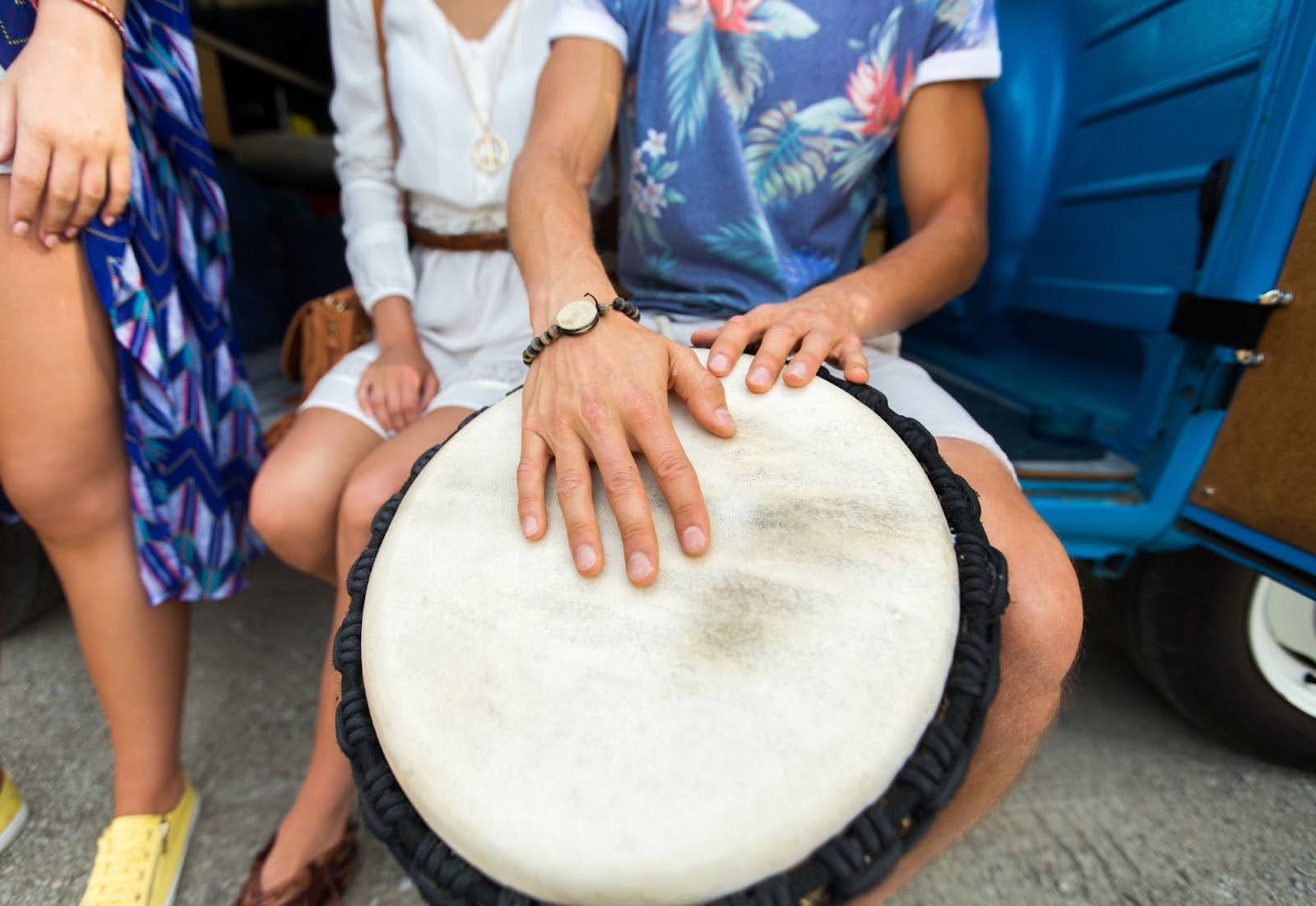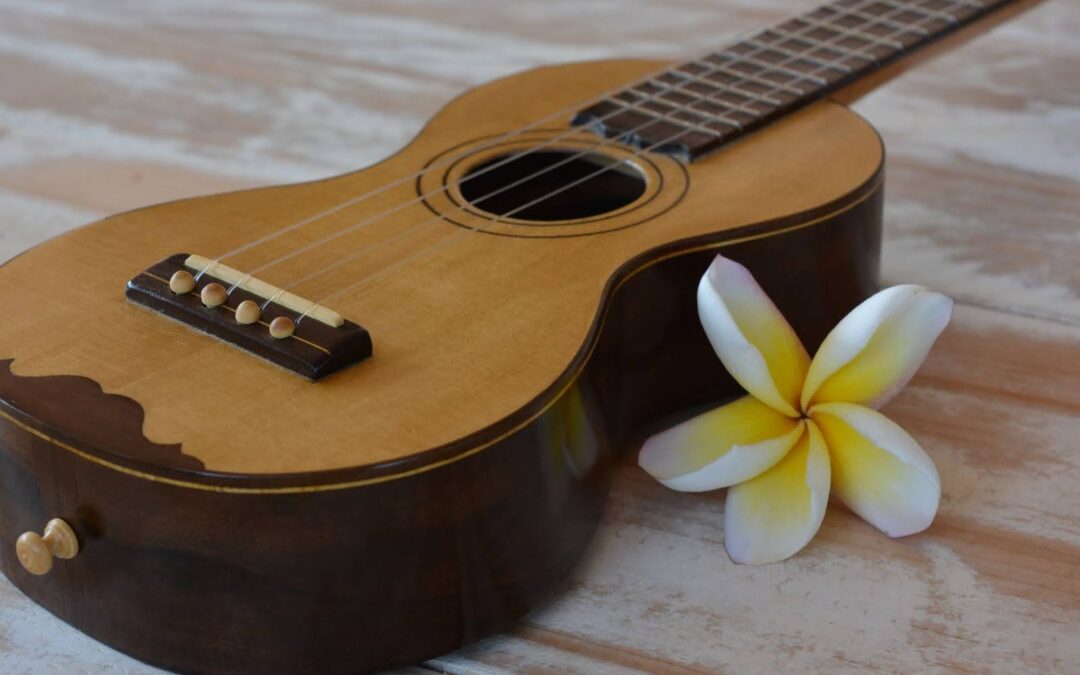Besides just producing beautiful music, the instruments in a lūʻau represent the cultural roots and legacy of Hawaiʻi. A lūʻau would not be possible without music. A variety of instruments are used to create the lifeblood of the lūʻau. These instruments include the ipu, pahu, ʻiliʻili, puʻili, pū, and in the case of modern hula, ʻukulele, guitar, and bass. Music at hulas unite the players, the audience, ancestors, and the divine. Experience this spiritual unity at our authentic Waikīkī hula shows, where traditional instruments create the heartbeat of Hawaiian culture. This blog will dive into the role, construction, and history of each instrument used in hula.
Percussion
Ipu (Gourd Drum)
The ipu has multiple roles in Hawaiian culture. It can be used to carry and store things, but it also can produce kani (sound) for mele (song). There are two different species of the ipu, the ipu nui and ipu ʻawa ʻawa. The former is mostly used for carrying and the latter is used in hula. The flesh is cleaned out of the ipu and it is dried out to form a container. It is wrapped in a kōkō (coconut sennit net) to aid in carrying. Ipu hōkiōkiō are small gourd whistles that produce kani (sound). The ipu is hollowed out and holes are drilled in it. The owner of the ipu would use it by blowing air out of their nose into the top hole and playing the other holes with their fingers. There is also the ipu paʻi and the hula ipu heke. The ipu paʻi is a hand held musical instrument. The hula ipu heke is made of two different gourds, and it is used like a drum.
Pahu (Sacred Drum)
The pahu is a type of drum made of hollowed-out log and a sharkskin drumhead. Instead of sharkskin, in modern times, cow-hide is used. The pahu is believed to be sacred. The pahu is very important for hula as it leads dancers. Hear the sacred leo (voice) of the pahu guiding our dancers at traditional Oʻahu lūʻau. Prayers were often included in the creation of the pahu in pre-European times. Laʻamaikahiki brought the first pahu to Hawaiʻi. The sounds the pahu makes are called the leo (voice) and the drum head is called the waha (mouth). The pahu has been thought to be a receptacle for a god. The drum represents Hawaiian perceptions of timing in traditional music. Pahu were greatly treasured and passed down from generation to generation.

ʻIliʻili (Stone Castanets)
ʻIliʻili are smooth river stones that are tapped together to produce a rhythm to dance to. The stones come from volcanic rock and have been smoothed by water. They are played in a set of four. The stones are held in fingers or the palm of the hand when played. They are similar to castanets used in latin music. They vary in size and shape. Each kind produces a different sound. Thin stones have a glassy sound while thick ones make clunky noises. They are dark in color and made of basalt.
Puʻili (Bamboo Rattles)
The puʻili are bamboo rattles with a handle on one end. A rustling sound emits when they are tapped against a dancer’s body (palms, shoulders, and knees), on the ground, or when they are rubbed together. The instruments create percussion sounds and create a visual spectacle during the performance. Puʻili are used both in hula kahiko (ancient hula) and hula ʻauana (modern hula). The sound of the instrument depends on its length. They are used while standing and sitting. They are often played in pairs. Sometimes the puʻili are decorated with carvings, painted, or wrapped in fabric. They are believed to bring harmony and unity.
Pū (Conch Shell Trumpet)
The pū is blown at the beginning of the lūʻau to signify the beginning of a ceremony. It is a call to the gods. Blowing the pū can mean hello, goodbye, and Mahalo (thanks). Its deep sound is also used to complement chants during the lūʻau. Sometimes mouthpieces are inserted in the instrument of metal, wood, or bamboo. The sound is very loud and can be heard from a great distance. The instrument has also been historically used to announce a boat arriving and to communicate with boats on the water. The pū was also used in Hawaiian warfare. It would announce the location and movement of soldiers. It also would announce the presence of aliʻi or chiefs. The pū’s echoing sound is a call to the ancestors.
Modern Lūʻau Music Setup
Hula ʻauana is the modern form of hula performed at a lūʻau. It uses more modern instruments like the ʻukulele, guitar, and bass. The ʻukulele originated in Hawaiʻi, which came from the Portuguese braguinha. It became popular in the 20th century. The kīkā kila hōʻalu is the slack key guitar. This style of guitar creates a relaxed, open sound. This instrument was created in Hawaiʻi. It symbolizes the combination of Hawaiian and Western musical traditions. The bass guitar is also incorporated in modern lūʻau bands. These instruments accompany the traditional instruments. Modern lūʻau music can be a variety of styles.
Putting It All Together
Each instrument, made with traditional Hawaiian resources, represents the island’s history. From warfare to communication with the Gods, these instruments tell the story of Hawaiʻi’s people. Modern instruments, like the guitar, ʻukulele, and bass combine with the traditional ones to keep the culture prominent. The music at a lūʻau is more than a performance, but a connection of people in current and past times. Don’t just read about these instruments—hear their ancient voices and feel their mana (spiritual power) at our Honolulu hula shows and Waikīkī lūʻau. Visit a lūʻau in Hawaiʻi to experience the beauty and importance of these instruments in telling Hawaiʻi’s story.
